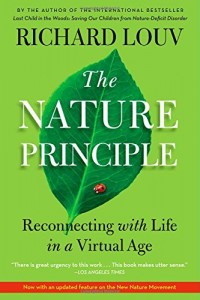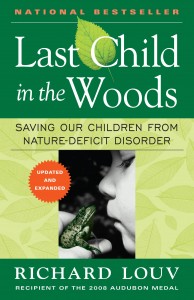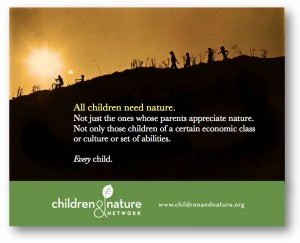THE RIGHT TO A WALK IN THE WOODS: Children’s Connection To The Natural World Should Be Considered A Human Right
This essay originally appeared as “A Walk in the Woods” in the March/April 2009 issue of Orion magazine. In 2011, it was adapted and expanded in Richard Louv’s book, The Nature Principle.
A few years ago, I visited Southwood Elementary, the grade school I attended when I was a boy growing up in Raytown, Missouri. I asked a classroom of children about their relationship with nature. Many of them offered the now-typical response: they preferred playing video games; they favored indoor activities—and when they were outside, they played soccer or some other adult-organized sport. But one fifth-grader, described by her teacher as “our little poet,” wearing a plain print dress and an intensely serious expression, said, “When I’m in the woods, I feel like I’m in my mother’s shoes.”

To her, nature represented beauty, refuge, and something else.
“It’s so peaceful out there and the air smells so good. For me, it’s completely different there,” she said. “It’s your own time. Sometimes I go there when I’m mad—and then, just with the peacefulness, I’m better. I can come back home happy, and my mom doesn’t even know why.”
She paused.
“I had a place. There was a big waterfall and a creek on one side of it,” she said. “I’d dug a big hole there, and sometimes I’d take a tent back there, or a blanket, and just lay down in the hole, and look up at the trees and sky. Sometimes I’d fall asleep back in there. I just felt free; it was like my place, and I could do what I wanted, with nobody to stop me. I used to go down there almost every day.” The young poet’s face flushed. Her voice thickened. “And then they just cut the woods down. It was like they cut down part of me.”
I was struck by her last comment: “It was like they cut down part of me.” If E. O. Wilson’s biophilia hypothesis is right—that human beings are hard-wired to get their hands wet and their feet muddy in the natural world—then the little poet’s heartfelt statement was more than metaphor. When she referred to her woods as “part of me,” she was describing something impossible to quantify: her primal biology, her sense of wonder, an essential part of her self.
But consider the echo from folks who reside at another point on the political/cultural spectrum, where nature is the object of human dominion, a distraction on the way to Paradise. In practice, these two views of nature are radically different. Yet, on one level, the similarity is striking: nature remains the “other.” Humans are in it, but not of it.
The basic concept of rights made some people uncomfortable. One friend asked, In a world in which millions of children are brutalized every day, can we spare time to forward a child’s right to experience nature? Good question. Others pointed out that we live in an era of litigation inflation and rights deflation; too many people believe they have a “right” to a parking spot, a “right” to cable TV, even a “right” to live in a neighborhood that bans children. Do we really need to add more “rights” to our catalogue of entitlements? Another good question.
The answer to both questions is yes, if we can agree that the right at issue is fundamental to our humanity, to our being.

A growing body of scientific evidence identifies strong correlations between experience in the natural world and children’s ability to learn, along with their physical and emotional health. Stress levels, attention-deficit hyperactivity disorder, cognitive functioning—and more—are positively affected by time spent in nature. “In the same way that protecting water and protecting air are strategies for promoting public health,” says Howard Frumkin, director of the National Center for Environmental Health at the Centers for Disease Control and Prevention [now Dean of the School of Public Health at the University of Washington], “protecting natural landscapes can be seen as a powerful form of preventive medicine.” For example, researchers at Indiana University School of Medicine, Indiana University–Purdue University at Indianapolis, and the University of Washington reported that greener neighborhoods are associated with slower increases in children’s body mass, regardless of residential density. Such research will be immensely helpful as we rethink our approaches to urban design, education, and health care, in particular our societal response to childhood obesity.
Yes, we need more research, says Frumkin, “but we know enough to act.” To reverse the trends that disconnect children from nature, actions must be grounded in science, but also rooted in deeper earth.
In 2007, the National Forum on Children and Nature, an impressive collection of mayors, professors, conservationists, and business leaders, met in Washington DC to explore the disconnection between children and nature. The conversation was enlightening, at times passionate, but as the hours passed several of the attendees began to ask about quantification. Some were looking for a business model to apply to the challenge of introducing children to the natural world. Most saw the obvious need for more research. “I appreciate this discussion, but I’d like to say something,” announced Gerald L. Durley, Senior Pastor at Providence Missionary Baptist Church in Atlanta. Durley had helped found the Afro-American Cultural Organization and worked shoulder to shoulder with Martin Luther King Jr. He leaned forward and said, “A movement moves. It has life.”
The outcome of the civil rights movement might have been quite different, or at least delayed, had its leaders waited for more statistical proof to justify their cause, or focused on the metrics of lunch-counter sit-ins, Durley added. Some efforts proved successful, some were counterproductive. But the movement moved.
“When making a moral argument, there are no hard and fast rules, and such arguments can always be contended,” according to my friend Larry Hinman, professor of philosophy at the University of San Diego. “But most moral arguments are made based on one or two points. These include a set of consequences and a first principle— for example, respect for human rights.” Science sheds light on the measurable consequences of introducing children to nature; studies pointing to health and cognition benefits are immediate and concrete. We also need to articulate the underlying “first principle”—one that emerges not only from what science can prove, but also from what it cannot fully reveal; one that resists codification because it is so elemental: a meaningful connection to the natural world is fundamental to our survival and spirit, as individuals and as a species.
In our time, Thomas Berry presented this inseparability most eloquently. A Catholic priest of the Passionist order and founder of the History of Religions Program at Fordham University and the Riverdale Center of Religious Research, for the better part of his ninety-four years on the planet Berry was prescient.

Berry incorporated Wilson’s biological view within a wider, cosmological context. In his book The Great Work, he wrote: “The present urgency is to begin thinking within the context of the whole planet, the integral Earth community with all its human and other-than-human components. When we discuss ethics we must understand it to mean the principles and values that govern that comprehensive community.”
The natural world is the physical manifestation of the divine, Berry believed. The survival of both religion and science depends not on one winning (because then both would lose), but on the emergence of what he calls a third story, a twenty- first-century story. Speaking of absolutes may make us uncomfortable, but surely this is true: As a society, we need to give nature back to our kids. Not doing that is immoral. It is unethical.
In the formation of American ideals, nature was elemental to the idea of human rights. Inherent in the thinking of the Founding Fathers was this assumption: with every right comes responsibility. Whether we are talking about democracy or nature, if we fail to serve as careful stewards, we will destroy the reason for our right, and the right itself. Those of us who identify ourselves as conservationists or environmentalists—whatever word we prefer—nearly always have had some transcendent experience in the natural world, usually in the form of independent play, with hands muddy, feet wet. We cannot love what we do not know. As Robert Michael Pyle puts it so well, “What is the extinction of a condor to a child who has never seen a wren?”
We must do more than talk about the importance of nature; we must ensure that children in every kind of neighborhood have everyday access to natural spaces, places, and experiences. To make that happen, this truth must become evident: we can truly care for nature and ourselves only if we see ourselves and nature as inseparable, only if we love ourselves as part of nature, only if we believe that our children have a right to the gifts of nature undestroyed.
The little girl in Raytown may not have a specific right to that particular tree in her chosen woods, but she does have the inalienable right to be with other life; to liberty, which cannot be realized under protective house arrest; and to the pursuit of happiness, which is made whole by the universe.
Postscript:
In September, 2012, the World Congress of the International Union for Conservation of Nature (IUCN), meeting in Jeju, South Korea, passed a resolution declaring that children have a human right to experience the natural world. Dutch human rights lawyer Annelies Henstra, the IUCN’s Keith Wheeler and Cheryl Charles, co-founder of the Children & Nature Network, and others made the case to the Congress — attended by more than 10,000 people representing the governments of 150 nations and more than 1,000 non-governmental organizations. The resolution, “the Child’s Right to Connect with Nature and to a Healthy Environment,”calls on IUCN’s membership to promote the inclusion of this right within the framework of the United Nations Convention on the Rights of the Child. The resolution recognizes “concern about the increasing disconnection of people and especially children from nature, and the adverse consequences for both healthy child development (‘nature deficit disorder’) as well as responsible stewardship for nature and the environment in the future.” And it recognizes that:
“…children, since they are an inalienable part of nature, not only have the right to a healthy environment, but also to a connection with nature and to the gifts of nature for their physical and psychological health and ability to learn and create, and that until they have these rights they will not bear responsibility for nature and the environment…” According to the IUCN World Congress resolution, the World Congress is also convinced “that growing up in a healthy environment and connecting children with nature is of such a fundamental importance for both children and the (future of) the conservation of nature and the protection of the environment, that it should be recognized and codified internationally as a human right for children.”
Full text of the Resolution can be read here.
Photo Shutterstock/Catelin Petolea


